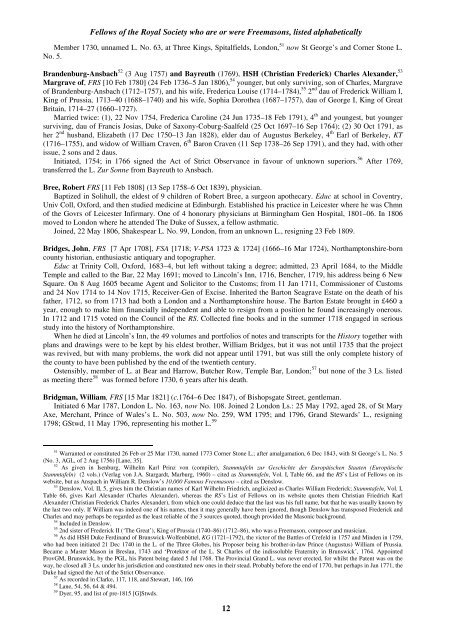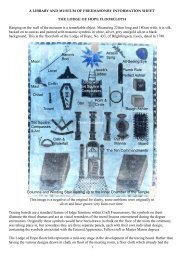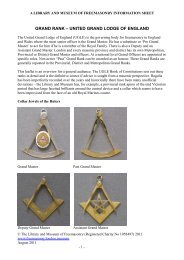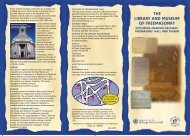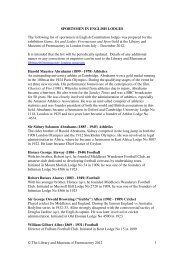FREEMASONS AND THE ROYAL SOCIETY Alphabetical List of ...
FREEMASONS AND THE ROYAL SOCIETY Alphabetical List of ...
FREEMASONS AND THE ROYAL SOCIETY Alphabetical List of ...
Create successful ePaper yourself
Turn your PDF publications into a flip-book with our unique Google optimized e-Paper software.
Fellows <strong>of</strong> the Royal Society who are or were Freemasons, listed alphabetically<br />
Member 1730, unnamed L. No. 63, at Three Kings, Spitalfields, London, 51 now St George’s and Corner Stone L.<br />
No. 5.<br />
Brandenburg-Ansbach 52 (3 Aug 1757) and Bayreuth (1769), HSH (Christian Frederick) Charles Alexander, 53<br />
Margrave <strong>of</strong>, FRS [10 Feb 1780] (24 Feb 1736–5 Jan 1806), 54 younger, but only surviving, son <strong>of</strong> Charles, Margrave<br />
<strong>of</strong> Brandenburg-Ansbach (1712–1757), and his wife, Frederica Louise (1714–1784), 55 2 nd dau <strong>of</strong> Frederick William I,<br />
King <strong>of</strong> Prussia, 1713–40 (1688–1740) and his wife, Sophia Dorothea (1687–1757), dau <strong>of</strong> George I, King <strong>of</strong> Great<br />
Britain, 1714–27 (1660–1727).<br />
Married twice: (1), 22 Nov 1754, Frederica Caroline (24 Jun 1735–18 Feb 1791), 4 th and youngest, but younger<br />
surviving, dau <strong>of</strong> Francis Josias, Duke <strong>of</strong> Saxony-Coburg-Saalfeld (25 Oct 1697–16 Sep 1764); (2) 30 Oct 1791, as<br />
her 2 nd husband, Elizabeth (17 Dec 1750–13 Jan 1828), elder dau <strong>of</strong> Augustus Berkeley, 4 th Earl <strong>of</strong> Berkeley, KT<br />
(1716–1755), and widow <strong>of</strong> William Craven, 6 th Baron Craven (11 Sep 1738–26 Sep 1791), and they had, with other<br />
issue, 2 sons and 2 daus.<br />
Initiated, 1754; in 1766 signed the Act <strong>of</strong> Strict Observance in favour <strong>of</strong> unknown superiors. 56 After 1769,<br />
transferred the L. Zur Sonne from Bayreuth to Ansbach.<br />
Bree, Robert FRS [11 Feb 1808] (13 Sep 1758–6 Oct 1839), physician.<br />
Baptized in Solihull, the eldest <strong>of</strong> 9 children <strong>of</strong> Robert Bree, a surgeon apothecary. Educ at school in Coventry,<br />
Univ Coll, Oxford, and then studied medicine at Edinburgh. Established his practice in Leicester where he was Chmn<br />
<strong>of</strong> the Govrs <strong>of</strong> Leicester Infirmary. One <strong>of</strong> 4 honorary physicians at Birmingham Gen Hospital, 1801–06. In 1806<br />
moved to London where he attended The Duke <strong>of</strong> Sussex, a fellow asthmatic.<br />
Joined, 22 May 1806, Shakespear L. No. 99, London, from an unknown L., resigning 23 Feb 1809.<br />
Bridges, John, FRS [7 Apr 1708], FSA [1718; V-PSA 1723 & 1724] (1666–16 Mar 1724), Northamptonshire-born<br />
county historian, enthusiastic antiquary and topographer.<br />
Educ at Trinity Coll, Oxford, 1683–4, but left without taking a degree; admitted, 23 April 1684, to the Middle<br />
Temple and called to the Bar, 22 May 1691; moved to Lincoln’s Inn, 1716, Bencher, 1719, his address being 6 New<br />
Square. On 8 Aug 1605 became Agent and Solicitor to the Customs; from 11 Jan 1711, Commissioner <strong>of</strong> Customs<br />
and 24 Nov 1714 to 14 Nov 1715, Receiver-Gen <strong>of</strong> Excise. Inherited the Barton Seagrave Estate on the death <strong>of</strong> his<br />
father, 1712, so from 1713 had both a London and a Northamptonshire house. The Barton Estate brought in £460 a<br />
year, enough to make him financially independent and able to resign from a position he found increasingly onerous.<br />
In 1712 and 1715 voted on the Council <strong>of</strong> the RS. Collected fine books and in the summer 1718 engaged in serious<br />
study into the history <strong>of</strong> Northamptonshire.<br />
When he died at Lincoln’s Inn, the 49 volumes and portfolios <strong>of</strong> notes and transcripts for the History together with<br />
plans and drawings were to be kept by his eldest brother, William Bridges, but it was not until 1735 that the project<br />
was revived, but with many problems, the work did not appear until 1791, but was still the only complete history <strong>of</strong><br />
the county to have been published by the end <strong>of</strong> the twentieth century.<br />
Ostensibly, member <strong>of</strong> L. at Bear and Harrow, Butcher Row, Temple Bar, London; 57 but none <strong>of</strong> the 3 Ls. listed<br />
as meeting there 58 was formed before 1730, 6 years after his death.<br />
Bridgman, William, FRS [15 Mar 1821] (c.1764–6 Dec 1847), <strong>of</strong> Bishopsgate Street, gentleman.<br />
Initiated 6 Mar 1787, London L. No. 163, now No. 108. Joined 2 London Ls.: 25 May 1792, aged 28, <strong>of</strong> St Mary<br />
Axe, Merchant, Prince <strong>of</strong> Wales’s L. No. 503, now No. 259, WM 1795; and 1796, Grand Stewards’ L., resigning<br />
1798; GStwd, 11 May 1796, representing his mother L. 59<br />
51<br />
Warranted or constituted 26 Feb or 25 Mar 1730, named 1773 Corner Stone L.; after amalgamation, 6 Dec 1843, with St George’s L. No. 5<br />
(No. 3, AGL, <strong>of</strong> 2 Aug 1756) [Lane, 35].<br />
52<br />
As given in Isenburg, Wilhelm Karl Prinz von (compiler), Stammtafeln zur Geschichte der Europäischen Staaten (Europäische<br />
Stammtafeln) (2 vols.) (Verlag von J.A. Stargardt, Marburg, 1960) – cited as Stammtafeln, Vol. I, Table 66, and the RS’s <strong>List</strong> <strong>of</strong> Fellows on its<br />
website, but as Anspach in William R. Denslow’s 10,000 Famous Freemasons – cited as Denslow.<br />
53<br />
Denslow, Vol. II, 5, gives him the Christian names <strong>of</strong> Karl Wilhelm Friedrich, anglicized as Charles William Frederick; Stammtafeln, Vol. I,<br />
Table 66, gives Karl Alexander (Charles Alexander), whereas the RS’s <strong>List</strong> <strong>of</strong> Fellows on its website quotes them Christian Friedrich Karl<br />
Alexander (Christian Frederick Charles Alexander), from which one could deduce that the last was his full name, but that he was usually known by<br />
the last two only. If William was indeed one <strong>of</strong> his names, then it may generally have been ignored, though Denslow has transposed Frederick and<br />
Charles and may perhaps be regarded as the least reliable <strong>of</strong> the 3 sources quoted, though provided the Masonic background.<br />
54<br />
Included in Denslow.<br />
55<br />
2nd sister <strong>of</strong> Frederick II (‘The Great’), King <strong>of</strong> Prussia (1740–86) (1712–86), who was a Freemason, composer and musician.<br />
56<br />
As did HSH Duke Ferdinand <strong>of</strong> Brunswick-Wolfenbüttel, KG (1721–1792), the victor <strong>of</strong> the Battles <strong>of</strong> Crefeld in 1757 and Minden in 1759,<br />
who had been initiated 21 Dec 1740 in the L. <strong>of</strong> the Three Globes, his Proposer being his brother-in-law Prince (Augustus) William <strong>of</strong> Prussia.<br />
Became a Master Mason in Breslau, 1743 and ‘Protektor <strong>of</strong> the L. St Charles <strong>of</strong> the indissoluble Fraternity in Brunswick’, 1764. Appointed<br />
ProvGM, Brunswick, by the PGL, his Patent being dated 5 Jul 1768. The Provincial Grand L. was never erected, for whilst the Patent was on the<br />
way, he closed all 3 Ls. under his jurisdiction and constituted new ones in their stead. Probably before the end <strong>of</strong> 1770, but perhaps in Jan 1771, the<br />
Duke had signed the Act <strong>of</strong> the Strict Observance.<br />
57<br />
As recorded in Clarke, 117, 118, and Stewart, 146, 166<br />
58 Lane, 54, 56, 64 & 494.<br />
59 Dyer, 95, and list <strong>of</strong> pre-1815 [G]Stwds.<br />
12


